KIA Optima 2008 2.G Service Manual
Manufacturer: KIA, Model Year: 2008, Model line: Optima, Model: KIA Optima 2008 2.GPages: 289, PDF Size: 4.78 MB
Page 41 of 289
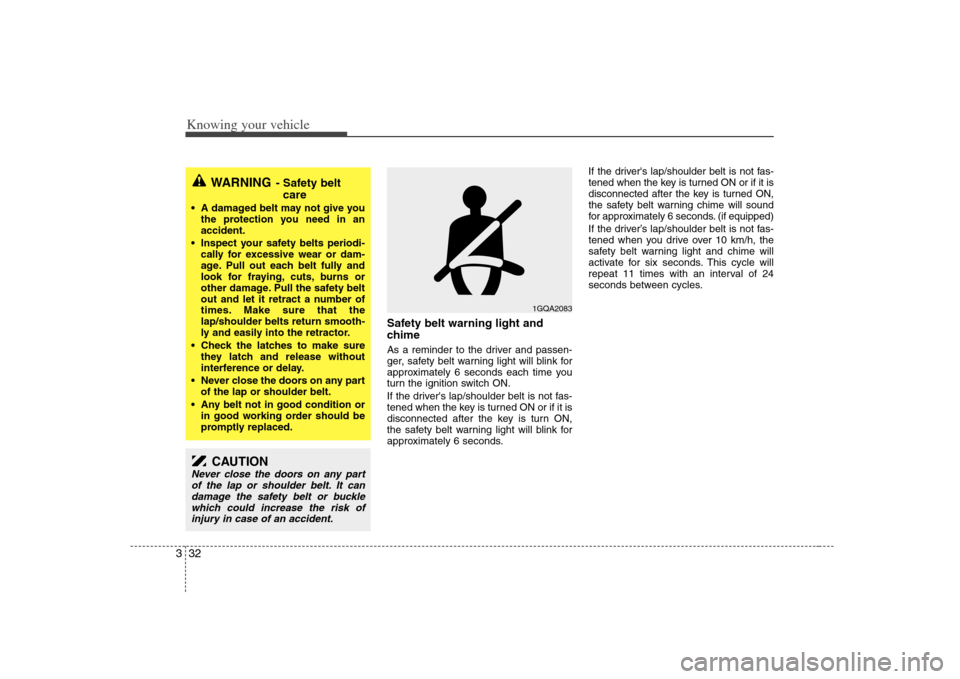
Knowing your vehicle32 3
Safety belt warning light and
chimeAs a reminder to the driver and passen-
ger, safety belt warning light will blink for
approximately 6 seconds each time you
turn the ignition switch ON.
If the driver's lap/shoulder belt is not fas-
tened when the key is turned ON or if it is
disconnected after the key is turn ON,
the safety belt warning light will blink for
approximately 6 seconds.If the driver's lap/shoulder belt is not fas-
tened when the key is turned ON or if it is
disconnected after the key is turned ON,
the safety belt warning chime will sound
for approximately 6 seconds. (if equipped)
If the driver’s lap/shoulder belt is not fas-
tened when you drive over 10 km/h, the
safety belt warning light and chime will
activate for six seconds. This cycle will
repeat 11 times with an interval of 24
seconds between cycles.
WARNING
- Safety belt
care
A damaged belt may not give you
the protection you need in an
accident.
Inspect your safety belts periodi-
cally for excessive wear or dam-
age. Pull out each belt fully and
look for fraying, cuts, burns or
other damage. Pull the safety belt
out and let it retract a number of
times. Make sure that the
lap/shoulder belts return smooth-
ly and easily into the retractor.
Check the latches to make sure
they latch and release without
interference or delay.
Never close the doors on any part
of the lap or shoulder belt.
Any belt not in good condition or
in good working order should be
promptly replaced.
CAUTION
Never close the doors on any part
of the lap or shoulder belt. It can
damage the safety belt or buckle
which could increase the risk of
injury in case of an accident.
1GQA2083
Page 42 of 289
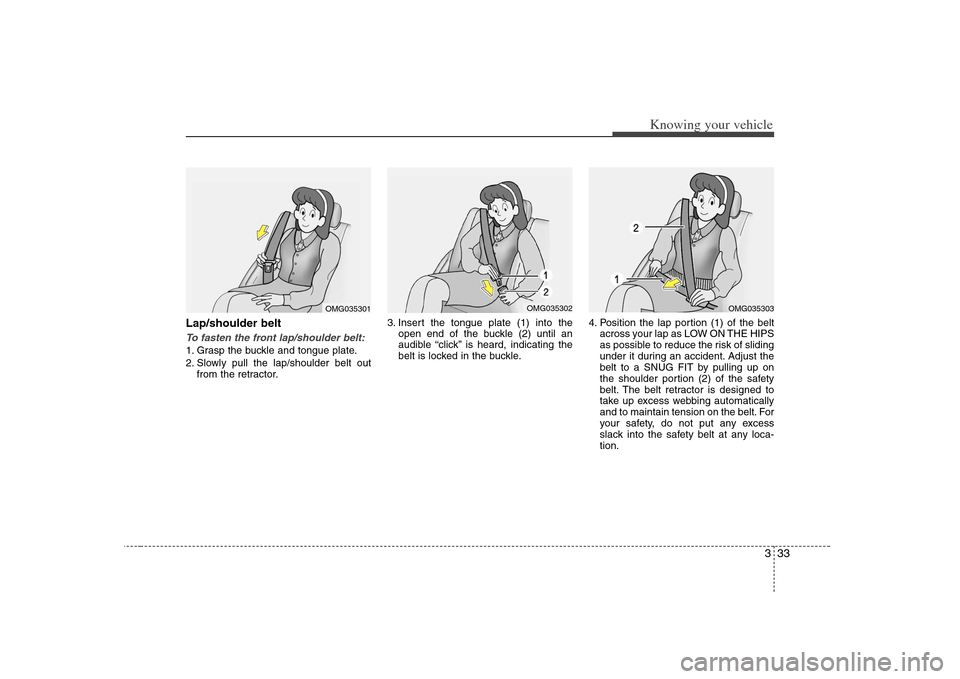
333
Knowing your vehicle
Lap/shoulder beltTo fasten the front lap/shoulder belt:1. Grasp the buckle and tongue plate.
2. Slowly pull the lap/shoulder belt out
from the retractor.3. Insert the tongue plate (1) into the
open end of the buckle (2) until an
audible “click” is heard, indicating the
belt is locked in the buckle.4. Position the lap portion (1) of the belt
across your lap as LOW ON THE HIPS
as possible to reduce the risk of sliding
under it during an accident. Adjust the
belt to a SNUG FIT by pulling up on
the shoulder portion (2) of the safety
belt. The belt retractor is designed to
take up excess webbing automatically
and to maintain tension on the belt. For
your safety, do not put any excess
slack into the safety belt at any loca-
tion.
OMG035303
OMG035301
OMG035302
Page 43 of 289

Knowing your vehicle34 35. Adjust the shoulder anchor position to
your size. To raise the anchor position,
push the anchor up (1). To lower the
anchor position, press (2) the button
(A) and slide the anchor down (3).
After adjustment, make sure the
anchor is locked in position.
If the height of the adjusting seat belt is
too near your neck, you will not be getting
the most effective protection. The shoul-
der portion should be adjusted so that it
lies across your chest and midway over
your shoulder nearest the door and not
your neck.
To unfasten the front lap/shoulder
belt:Press the release button on the buckle
and allow the belt to slowly retract.
OMG035304
WARNING
The height adjuster must be in
the locked position when the
vehicle is moving.
The misadjustment of height of
the shoulder belt could reduce
the effectiveness of the seat belt
in a crash.
OMG035038
Page 44 of 289
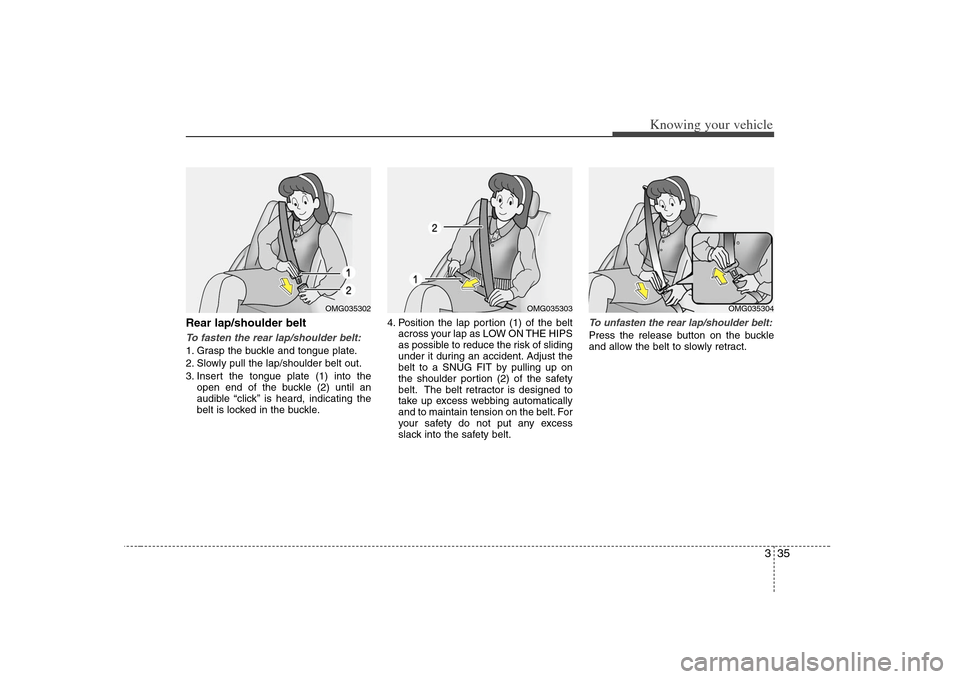
335
Knowing your vehicle
Rear lap/shoulder belt To fasten the rear lap/shoulder belt:1. Grasp the buckle and tongue plate.
2. Slowly pull the lap/shoulder belt out.
3. Insert the tongue plate (1) into the
open end of the buckle (2) until an
audible “click’’ is heard, indicating the
belt is locked in the buckle.4. Position the lap portion (1) of the belt
across your lap as LOW ON THE HIPS
as possible to reduce the risk of sliding
under it during an accident. Adjust the
belt to a SNUG FIT by pulling up on
the shoulder portion (2) of the safety
belt. The belt retractor is designed to
take up excess webbing automatically
and to maintain tension on the belt. For
your safety do not put any excess
slack into the safety belt.
To unfasten the rear lap/shoulder belt:Press the release button on the buckle
and allow the belt to slowly retract.
OMG035302
OMG035303
OMG035304
Page 45 of 289

Knowing your vehicle36 3✽
✽
NOTICEWhen returning the rear seatbacks to
the upright position, remember to
return the rear shoulder belts to their
proper position. Routing the safety belt
webbing through the rear safety belt
guides will help keep the belts from
being trapped behind or under the seats.
3 Point rear center belt
(if equipped) To fasten the rear center belt1. Insert the tongue plate (A) into the
open end of the anchor connector (B)
until an audible “click" is heard, indi-
cating the latch is locked. Make sure
the belt is not twisted.2. Pull the tongue plate (C) and insert the
tongue plate (C) into the open end of
the buckle (D) until an audible “click” is
heard, indicating the latch is locked.
Make sure the belt is not twisted.
OMG035042
(if equipped)
OMG035041
OMG035043
Page 46 of 289

337
Knowing your vehicle
There will be an audible “click” when the
tab locks in the buckle. The seat belt
automatically adjusts to the proper length
only after the lap belt is adjusted manu-
ally so that it fits snugly around your hips.
If you lean forward in a slow, easy
motion, the belt will extend and let you
move around. If there is a sudden stop or
impact, the belt will lock into position. It
will also lock if you try to lean forward too
quickly.
When using the rear center seat belt, the
buckle with the “CENTER” mark must be
used.
WARNING
When using the rear seat center
belt, you must lock all tongue plates
and buckle/anchor connector. If any
tongue plate or buckle/anchor con-
nector is not locked, it will increase
the chance of injury or death in the
event of collision.
OMG035039
WARNING
- Lock center
rear seat
When using the rear center belt,
you must lock all tongue plates
and buckles prior to use. If any
tongue plate or buckle is not
locked, it will increase the chance
of injury or death in the event of
collision.
The rear center seatbelt tongue
plate (A) and anchor connector
(B) should remain locked at all
times. They should only be
unlocked when folding the rear
seatback down or when carrying
an object in the rear seat that
could cause damage to the seat-
belt webbing or locking devices.
In either case, lock the tongue
plate (A) and anchor connector
(B) immediately after unfolding
the seatbacks or removing the
object being transported.
Page 47 of 289
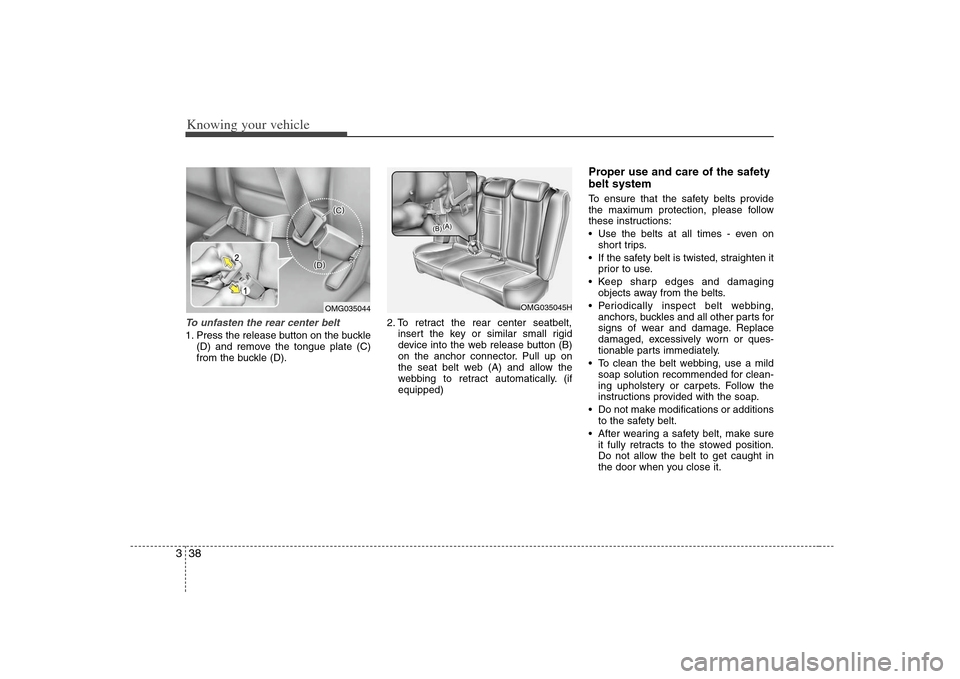
Knowing your vehicle38 3To unfasten the rear center belt 1. Press the release button on the buckle
(D) and remove the tongue plate (C)
from the buckle (D).2. To retract the rear center seatbelt,
insert the key or similar small rigid
device into the web release button (B)
on the anchor connector. Pull up on
the seat belt web (A) and allow the
webbing to retract automatically. (if
equipped)
Proper use and care of the safety
belt system To ensure that the safety belts provide
the maximum protection, please follow
these instructions:
Use the belts at all times - even on
short trips.
If the safety belt is twisted, straighten it
prior to use.
Keep sharp edges and damaging
objects away from the belts.
Periodically inspect belt webbing,
anchors, buckles and all other parts for
signs of wear and damage. Replace
damaged, excessively worn or ques-
tionable parts immediately.
To clean the belt webbing, use a mild
soap solution recommended for clean-
ing upholstery or carpets. Follow the
instructions provided with the soap.
Do not make modifications or additions
to the safety belt.
After wearing a safety belt, make sure
it fully retracts to the stowed position.
Do not allow the belt to get caught in
the door when you close it.
OMG035044
OMG035045H
Page 48 of 289
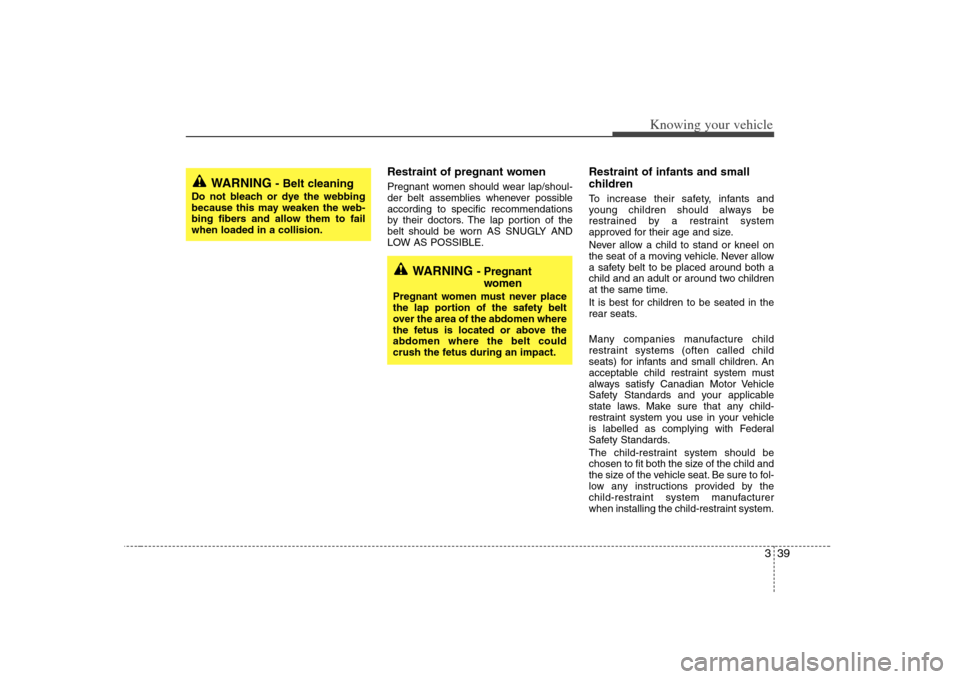
339
Knowing your vehicle
Restraint of pregnant women Pregnant women should wear lap/shoul-
der belt assemblies whenever possible
according to specific recommendations
by their doctors. The lap portion of the
belt should be worn AS SNUGLY AND
LOW AS POSSIBLE.
Restraint of infants and small
children To increase their safety, infants and
young children should always be
restrained by a restraint system
approved for their age and size.
Never allow a child to stand or kneel on
the seat of a moving vehicle. Never allow
a safety belt to be placed around both a
child and an adult or around two children
at the same time.
It is best for children to be seated in the
rear seats.
Many companies manufacture child
restraint systems (often called child
seats) for infants and small children. An
acceptable child restraint system must
always satisfy Canadian Motor Vehicle
Safety Standards and your applicable
state laws. Make sure that any child-
restraint system you use in your vehicle
is labelled as complying with Federal
Safety Standards.
The child-restraint system should be
chosen to fit both the size of the child and
the size of the vehicle seat. Be sure to fol-
low any instructions provided by the
child-restraint system manufacturer
when installing the child-restraint system.
WARNING
- Pregnant
women
Pregnant women must never place
the lap portion of the safety belt
over the area of the abdomen where
the fetus is located or above the
abdomen where the belt could
crush the fetus during an impact.
WARNING
- Belt cleaning
Do not bleach or dye the webbing
because this may weaken the web-
bing fibers and allow them to fail
when loaded in a collision.
Page 49 of 289
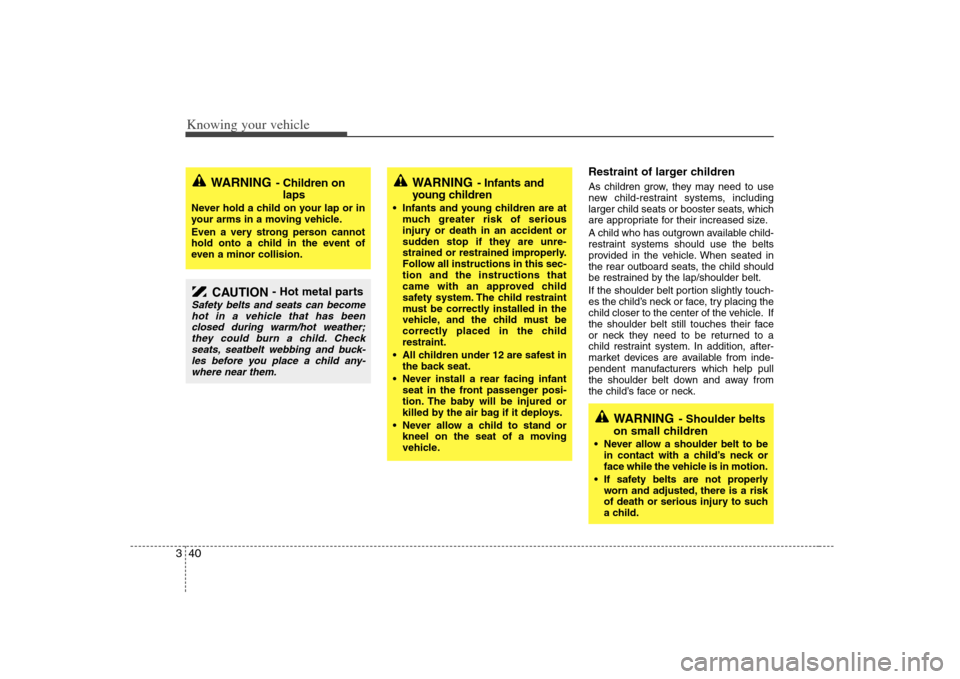
Knowing your vehicle40 3
Restraint of larger children As children grow, they may need to use
new child-restraint systems, including
larger child seats or booster seats, which
are appropriate for their increased size.
A child who has outgrown available child-
restraint systems should use the belts
provided in the vehicle. When seated in
the rear outboard seats, the child should
be restrained by the lap/shoulder belt.
If the shoulder belt portion slightly touch-
es the child’s neck or face, try placing the
child closer to the center of the vehicle. If
the shoulder belt still touches their face
or neck they need to be returned to a
child restraint system. In addition, after-
market devices are available from inde-
pendent manufacturers which help pull
the shoulder belt down and away from
the child’s face or neck.
WARNING
- Infants and
young children
Infants and young children are at
much greater risk of serious
injury or death in an accident or
sudden stop if they are unre-
strained or restrained improperly.
Follow all instructions in this sec-
tion and the instructions that
came with an approved child
safety system. The child restraint
must be correctly installed in the
vehicle, and the child must be
correctly placed in the child
restraint.
All children under 12 are safest in
the back seat.
Never install a rear facing infant
seat in the front passenger posi-
tion. The baby will be injured or
killed by the air bag if it deploys.
Never allow a child to stand or
kneel on the seat of a moving
vehicle.
WARNING
- Children on
laps
Never hold a child on your lap or in
your arms in a moving vehicle.
Even a very strong person cannot
hold onto a child in the event of
even a minor collision.
CAUTION
- Hot metal parts
Safety belts and seats can become
hot in a vehicle that has been
closed during warm/hot weather;
they could burn a child. Check
seats, seatbelt webbing and buck-
les before you place a child any-
where near them.
WARNING
- Shoulder belts
on small children
Never allow a shoulder belt to be
in contact with a child’s neck or
face while the vehicle is in motion.
If safety belts are not properly
worn and adjusted, there is a risk
of death or serious injury to such
a child.
Page 50 of 289
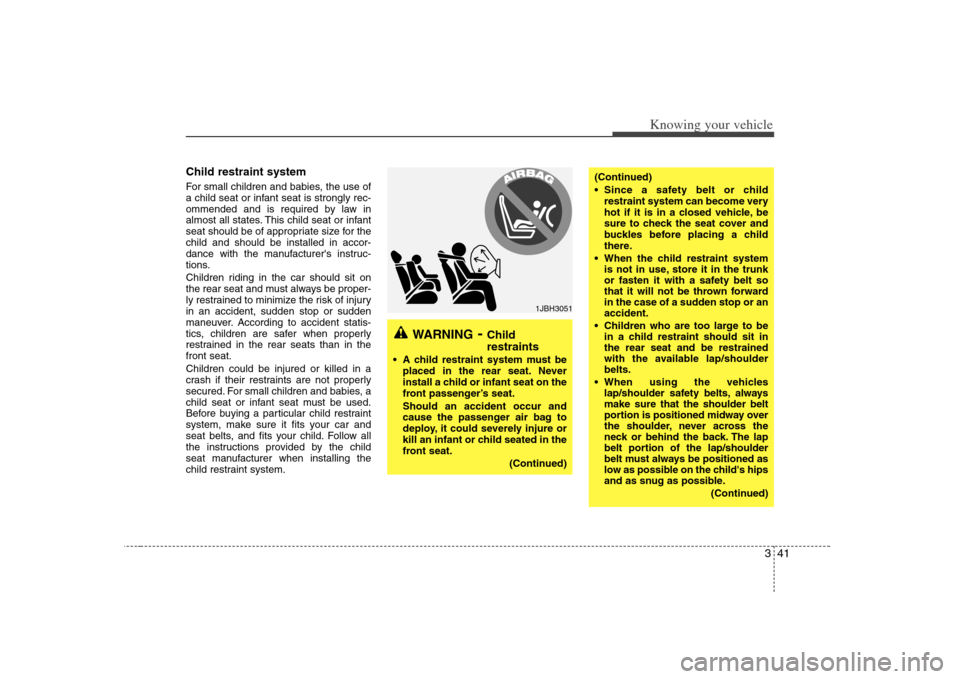
341
Knowing your vehicle
Child restraint system For small children and babies, the use of
a child seat or infant seat is strongly rec-
ommended and is required by law in
almost all states. This child seat or infant
seat should be of appropriate size for the
child and should be installed in accor-
dance with the manufacturer's instruc-
tions.
Children riding in the car should sit on
the rear seat and must always be proper-
ly restrained to minimize the risk of injury
in an accident, sudden stop or sudden
maneuver. According to accident statis-
tics, children are safer when properly
restrained in the rear seats than in the
front seat.
Children could be injured or killed in a
crash if their restraints are not properly
secured. For small children and babies, a
child seat or infant seat must be used.
Before buying a particular child restraint
system, make sure it fits your car and
seat belts, and fits your child. Follow all
the instructions provided by the child
seat manufacturer when installing the
child restraint system.
1JBH3051
WARNING
- Child
restraints
A child restraint system must be
placed in the rear seat. Never
install a child or infant seat on the
front passenger’s seat.
Should an accident occur and
cause the passenger air bag to
deploy, it could severely injure or
kill an infant or child seated in the
front seat.
(Continued)
(Continued)
Since a safety belt or child
restraint system can become very
hot if it is in a closed vehicle, be
sure to check the seat cover and
buckles before placing a child
there.
When the child restraint system
is not in use, store it in the trunk
or fasten it with a safety belt so
that it will not be thrown forward
in the case of a sudden stop or an
accident.
Children who are too large to be
in a child restraint should sit in
the rear seat and be restrained
with the available lap/shoulder
belts.
When using the vehicles
lap/shoulder safety belts, always
make sure that the shoulder belt
portion is positioned midway over
the shoulder, never across the
neck or behind the back. The lap
belt portion of the lap/shoulder
belt must always be positioned as
low as possible on the child's hips
and as snug as possible.
(Continued)